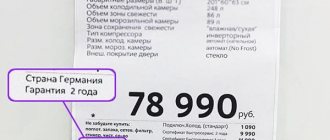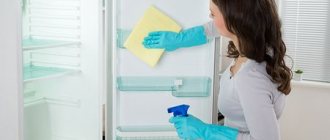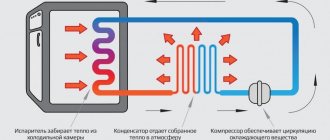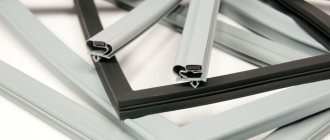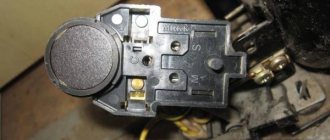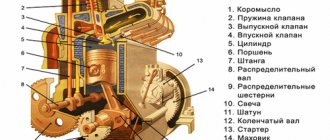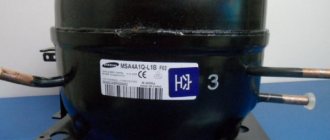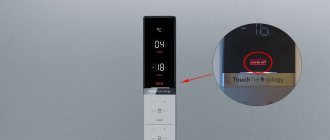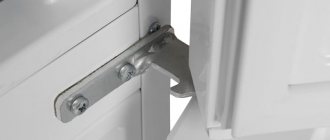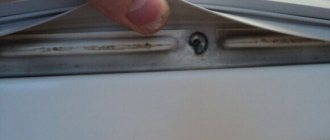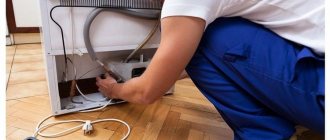Refrigerator error codes
The No Frost dry freezing system uses a fan located inside the refrigerator compartment. Its use leads to the fact that the cold air flows inside are constantly mixed and the products are cooled more evenly. After warming up, the air takes in the condensation that has formed and discharges it outside.
This method of operation is possible due to the fact that the Samsung two-chamber No Frost refrigerator is highly reliable. However, over time, equipment wears out and the likelihood of malfunctions increases. In such a situation, it is important to correctly determine the cause of the problem. Of course, by calling a specialist, this is not difficult to do.
Important! Samsung has created a built-in electronic diagnostic system in its refrigerators, which allows even an inexperienced user to determine what happened to the equipment.
However, in order to do this, you need to know how to use such diagnostics. Based on the data received from the sensors, it draws conclusions about the nature of the malfunction that occurred. After analyzing the information received by it, it determines the type of malfunction and displays an error code on the display located on the panel.
Knowing how to read it correctly, the user can easily find out the type of problem that has arisen in the Samsung No Frost refrigerator. There are instructions that detail what needs to be done in each situation, depending on the code issued by the system. At the same time, you can immediately see when you can take independent action, and in which cases you need to call a specialist. The list of malfunctions of the Samsung No Frost two-chamber refrigerator can be found in the corresponding table.
Error Code Table
Samsung refrigerator error codes
Since Samsung refrigerators are equipped with electronic controls, if there is a malfunction, an error code is displayed on the display. Let's look at what this or that code means:
- Ice maker malfunction. If this function is present, then you need to pay attention to the condition of the corresponding compartment and test the operation of the temperature sensor.
- Temperature sensor failure. To conduct a full diagnosis, it must be removed and carefully examined. If there are changes in the color of the electronic board, the regulator must be replaced with a new one. It would not be superfluous to inspect the wires and components associated with the sensor.
- Malfunction of the defrost sensor. In the vast majority of cases, it will not be possible to repair it. It must be replaced with a new one. However, if damage to the wires is detected, you can try to fix the problem yourself.
- Fan failure. This unit is responsible for air circulation inside the refrigerator chambers. The most obvious sign of a breakdown is an increase in temperature. To diagnose the condition of the fan, you need to remove the back wall of the refrigeration unit.
- Ice maker malfunction. It manifests itself in jamming of the ejector plate. It needs to be removed, cleaned and installed back.
- Malfunction of the temperature control sensor in the freshness zone. If it fails, you will have to replace it.
- Temperature level control error. If it appears, then you need to check the part as quickly as possible and, if necessary, replace it with a new one. If this is not done, the breakdown will cause the compressor to fail.
- Faulty freezer compartment sensor.
- Defrost sensor failure. If diagnostics show that the part does not work, then it needs to be replaced with a new one.
- Air circulation failure in the freezer compartment. The first stage of troubleshooting is eliminating ice. The second is diagnosing the wiring condition.
- Moisture condenser malfunction. After diagnosis, the canals are cleaned.
Almost all of these problems can be corrected yourself. In the next section, we'll look at how to troubleshoot problems at home.
Typical faults
In most cases, users of such refrigerators encounter the following problems:
- The freezer stops working. After a failure, it no longer maintains a low temperature. Often, water begins to flow out of the freezer, which was formed from melted ice. The cause of the breakdown may be elementary. For example, this may be a consequence of icing on the freezer door, which has broken the seal of the structure.
- Some errors are not related to breakdowns, but are a consequence of the user making incorrect adjustments. Accurate diagnostics in such situations will allow you to restore the equipment to its previous level.
- Sometimes a manufacturing defect can lead to problems. In such situations, sometimes you can fix the problem yourself, but in other situations you will have to resort to warranty repairs.
The device does not turn on
If the refrigerator has stopped freezing, then usually the first sign is water leakage, which is caused by an increase in temperature. If the user has not opened the refrigerator for a long time, then upon opening the faulty device for the first time, he may notice an unpleasant odor from food that has recently begun to deteriorate. Before you set the temperature in your Samsung refrigerator, you need to fix the problem that has arisen.
One possible reason could be that a foreign object has gotten under the back cover. Usually it gets stuck there because the ice holds it. In this case, it is enough to use a hairdryer to fix the problem. The flow of warm air will melt the ice. After this, the foreign object will either fall out on its own, or it can be easily reached and removed.
If the reason for the stoppage is the compressor, then this can be detected by the fact that it clicks, but does not start. The cause could be, for example, a short circuit or a broken wire. To accurately diagnose it and find the cause of the malfunction, special equipment will be required. In such a situation, when repairing a Samsung No Frost refrigerator, you will definitely need to contact a specialist.
Leave a request and receive a 15% discount on your first repair!
Submit your application
Stopping the operation of the equipment may be due to malfunctions in the electronic control board of the refrigerator or the sensors based on the signals on which it operates. If the control module is faulty, you will need to call service. If the air sensor or start-up relay is faulty, you can replace it yourself.
Advantages and disadvantages of No Frost technology
No Frost is a system in which the evaporator is moved outside the refrigeration compartment (the manufacturer installs it behind the back wall of the device, i.e. in the case, or above the freezer). A special fan blows in the cold, ensuring constant air circulation. In this case, excess moisture turns into snow and concentrates on the evaporator. When the compressor is turned off, the frost thaws and evaporates, relieving the owner of the problems associated with defrosting.
The advantages of Samsung No Frost models include:
- No need for frequent manual defrosting. It is enough to defrost refrigerators with No Frost every 6 or 12 months for them to work efficiently and uninterruptedly.
- Uniform temperature distribution. The No Frost system ensures uniform cooling of the device, so that the temperature on the lower and upper shelves remains almost the same. This promotes long-term preservation of products.
- Work at any temperature. No Frost in Samsung refrigerators works in the refrigerator and freezer compartments (unlike the drip system, which is not adapted to work at sub-zero temperatures).
- Quick set of indicators. The set temperature conditions are established quickly, also after switching on or loading food.
- Long-term preservation of cold during a power outage.
Disadvantages of Samsung refrigerators with No Frost:
- noisy work;
- high energy consumption;
- increased dimensions due to large evaporators;
- low level of air humidity (fraught with rapid drying of food);
- high price.
View » 4 secrets on how to choose the right refrigerator
Overheating of compartments
The operation of Samsung refrigerators and their competitors is based on precise temperature control. If this is not done, the temperature inside the device increases, which leads to problems. This is one of the common types of malfunctions of the Samsung No Frost two-chamber refrigerator.
His most common mistakes are the following:
- Placing hot foods in the refrigerator.
- Opening the refrigerator door frequently or leaving it open for a long time. At the same time, air from the room enters the refrigerator, increasing the temperature. This situation is especially unpleasant during the period when there was an emergency power outage. If you do not open a working refrigerator, then, according to Samsung No Frost, the operating instructions, it is able to maintain conditions acceptable for food for a day and a half.
- Malfunctions of a Samsung refrigerator can occur if there are heating devices in relative proximity to the device. This can happen, for example, in cases where the refrigerator is placed next to a heating radiator.
- If the seal is broken due to wear of the door gasket.
- In the case when the door is prevented from closing tightly by icing. It often occurs due to a seal failure, when the refrigerator cannot lower the temperature to the required extent and because of this, the compressor operates constantly.
Error codes
The self-diagnosis system can generate the following fault codes for a Samsung refrigerator:
- 01 — The appearance of such symbols indicates a malfunction of the ice maker sensor. If this device is included with the device, you need to test the sensor and replace it.
- 02 - Reports a breakdown of the temperature sensor. The part must be removed from the housing and inspected. If necessary, the regulator is replaced. You also need to check the condition of the wiring. If some components burn out, the diagnostic system may also generate an error code 02.
- 03 - Indicates a breakdown of the defrost sensor. You need to check this part and the wiring connected to it. If a malfunction is detected, these parts of the system are replaced.
- 04 - Indicates that the fan is not working properly. In a Samsung refrigerator with No Frost, this part is used to distribute air flow. Fan failure is accompanied by an increase in temperature in the chambers. If error 04 appears, you need to dismantle the back wall and check that the part is connected correctly.
- 05 - Indicates a problem with the ice maker. The part that pushes and compresses the ice may jam. If this happens frequently, the element needs to be checked and replaced.
- 06 — Failure of the temperature sensor, which ensures that the required temperature is maintained in the freshness zones. The part needs to be checked and replaced.
- 07 - Indicates a breakdown of the main compartment temperature sensor. In devices equipped with an electronic control system, the sensor detects the temperature of the internal space and transmits the data to the head unit. If the sensor breaks down, the compressor starts working without stopping, which leads to breakdown. The sensor must be replaced immediately.
- 08 - Indicates that the flow of data from the freezer temperature sensor has stopped. The part needs to be tested and replaced.
- 09 - Indicates a breakdown of the defrost sensor. The part is checked using a multimeter. The faulty sensor is replaced with a new one.
- 10 - Indicates that the fans in the freezer are not operating correctly. It is necessary to check the working surfaces for the presence of ice. The cables are inspected to determine the correct connection and the presence of breakdowns.
- 11 - The error appears when the capacitor is not working correctly. The element must be inspected for blockages. The part located outside may become covered with dust.
Ice
One common problem is ice buildup. This happens all the time. In most cases, to combat it, it is enough to periodically defrost the refrigerator. After this, you can use the standard method for adjusting the temperature in a Samsung refrigerator.
In this case, the device is turned off, the products are briefly moved to a cool place, cleaning the refrigerator and freezer. The temperature in the Samsung refrigerator is increasing. When exposed to room temperature, the ice melts. After this, the inside is wiped dry, the food is loaded back, and the Samsung refrigerator is turned on.
However, if the refrigerator is faulty, ice forms too quickly. If this happens, you need to find the cause and eliminate it.
In this case, the source of malfunction of the Samsung refrigerator may be the following:
- If you put hot food in the refrigerator. Of course, in this way they will cool faster than at room temperature, but at the same time they will greatly disrupt the thermal regime.
- One common cause is a damaged or worn door seal. It is necessary to regularly monitor his condition. If necessary, a new seal must be installed.
- Maintaining the selected temperature regime is impossible without proper operation of the thermal sensor. If it gives incorrect information, the temperature adjustment will not occur correctly. One of the possible consequences is a strong drop in temperature, which will lead to freezing of food and the formation of ice.
- The electronic control board of the refrigerator is faulty. For repairs you need to call a specialist.
- Refrigerant leakage is dangerous. Its deficiency disrupts the normal operation of the equipment. With less of it, cooling will become less effective, which can lead to prolonged continuous operation of the compressor and icing of the internal walls of the refrigerator.
Repairing freon leaks and refilling can only be done by specialists. Before you set up the refrigerator, you need to find and fix the problem.
Samsung refrigerator
How Samsung No Frost refrigerators break down
- Ice appears in the compartments. Possible problems are a malfunction of the evaporator, a clogged drain hole.
- The refrigerator starts making loud noise. Usually the sound increases gradually and imperceptibly - ice appears next to the fan, the blades rub against it more and more.
- Cycle failure. The reason is a temporary power outage. If the freeze-thaw cycle is interrupted, errors appear in the electronics and the device does not work correctly.
The only way to repair a No Frost refrigerator yourself is to defrost it. Turn off the device, remove the food and leave for 8-10 hours at room temperature. During this time, possible specks in the drainage channels will come out along with the melted water, the control system will “forget” about the failed cycle, and the ice that interfered with the work will disappear.
| So if there are any problems with your Samsung refrigerator, first try to defrost it. Perhaps a master is not required. But first, read the article about ways to preserve food without a refrigerator - this will help you wait out the shutdown. |
If this doesn’t help, then it’s time to call a professional. The thermal relay, timer, or defrost system fuse may have broken. Sometimes the heater wires break, problems appear with the compressor, and malfunctions in the electronic control system. A specialist will determine the cause on site and eliminate it immediately.
Preventative measures to prevent breakdowns
Important! Samsung equipment, despite its reliability and durability, gradually wears out over the years. At the same time, not only its quality is important, but also the conditions under which it is used. If you apply preventive measures in time, you can significantly extend the life of trouble-free operation.
To do this, it is recommended to do the following:
- Since ice will certainly build up, in order to get rid of it, it is necessary to periodically defrost the refrigerator. It is enough to do this every year. Before defrosting the refrigerator, you will need to turn it off.
- During this, shelves and drawers are cleaned and washed. In this case, do not use aggressive chemical detergents. It is recommended to use a soda solution for this.
- If contamination occurs, it must be removed as quickly as possible.
- When placing food in the refrigerator, you need to make sure that it is not hot.
- It is preferable to store products in special containers.
- It is necessary to control the shelf life of products placed in the refrigerator. If they become unfit for food, they must be removed immediately.
- At the first signs of a malfunction, you must try to determine what caused them and carry out repairs.
- The refrigerator must be used indoors. It is unacceptable for it to stand where it is exposed to moisture or direct sunlight. There should be no heating devices in the immediate vicinity.
With these simple measures, you can ensure the functionality of your refrigerator for decades.
